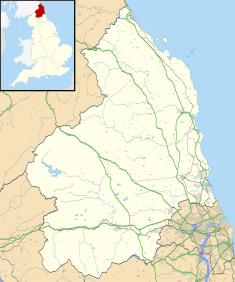Alnwick Town Hall
| Alnwick Town Hall | |
|---|---|
 Alnwick Town Hall | |
| Location | Market Place, Alnwick |
| Coordinates | 55°24′48″N 1°42′28″W / 55.4134°N 1.7077°W |
| Built | 1731 |
| Architectural style(s) | Neoclassical style |
Listed Building – Grade I | |
| Official name | Town Hall |
| Designated | 25 August 1977 |
| Reference no. | 1157140 |
Alnwick Town Hall is a municipal building in the Market Place, Alnwick, Northumberland, England. The structure, which was the meeting place of the common council, is a Grade I listed building.[1]
History[edit]
The first building on the site was an early 16th century "brewhouse" established by the Earl of Northumberland, as lord of the manor, before passing into private hands and then being acquired by the burgesses in 1585.[2] The burgesses operated it as a brewery for the people of the town but latterly used it as a tolbooth i.e. municipal building.[2] By the late 17th century the building was in a dilapidated state and the burgesses decided to demolish it and to erect a bespoke town hall in its place.[2]
The new building was designed in the neoclassical style, built in ashlar stone at a cost of £730 and was completed in 1731.[2] The design involved an asymmetrical main frontage with five bays facing onto the Market Place; it featured a steep flight of steps from the ground floor, built across the fourth bay and leading up to a first floor porch in the fifth bay.[1] In the central bay, there was a rusticated and arched entrance to a passageway going through to Fenkle Street.[1] There were sash windows in the other bays on the first floor.[1] At roof level, there was a parapet, and, on the rear elevation, there was a three stage tower with pediments on each side.[1] Internally, the principal room was the public hall, which was used for meetings of the common council, as well as quarter sessions hearings.[2] There were also two adjoining rooms.[2][3]
A clock, designed and manufactured by a Mr Bell, was added to the tower in 1767, a large shop front was installed in the first and second bays in 1770 and some small corner spires, designed by George Hastings, were added to the tower in 1771.[2] In the early 19th century theatrical events took place in the town hall with Stephen Kemble playing Falstaff there.[4] Illuminated dials were added to the clock, which had to be wound by hand,[5] in 1876.[6] Its borough council, which met in the town hall, was abolished under the Municipal Corporations Act 1883.[7]
After the town became an urban district in 1894,[8] the building remained in use by the urban district council until it moved to new offices at the site of the former Alnwick Workhouse in Wagonway Road after the Second World War.[9][10][11] The town hall became the venue for the annual Alnwick Beer Festival, when it was established in 2007,[12] and subsequently also become the venue for a local art gallery.[13]
See also[edit]
References[edit]
- ^ a b c d e Historic England. "Town Hall (1157140)". National Heritage List for England. Retrieved 19 August 2021.
- ^ a b c d e f g Tate, George (1866). The History of the Borough, Castle and the Barony of Alnwick. Vol. 2. Henry Hunter Blair. p. 285.
- ^ Parson, William; White, William (1827). History, directory and gazetteer of the Counties of Durham and Northumberland. W. White and Co. p. 389.
- ^ Blakey, Robert (1879). Memoirs. Trübner & Co. p. 14.
- ^ "'The heritage blew me away' It's like going back in time. Wooden stairs and beams, three vintage metal bells struck by hammers and a clockwork mechanism dating back to the 1870s". Northumberland Gazette. 10 December 2016. Retrieved 19 August 2021.
- ^ "Alnwick Town Hall". North East Bells. Retrieved 19 August 2021.
- ^ Municipal Corporations Act 1883 (46 & 46 Vict. Ch. 18) (PDF). 1883. Retrieved 18 April 2022.
- ^ "Alnwick UD". Vision of Britain. Retrieved 19 August 2021.
- ^ "No. 39714". The London Gazette. 9 December 1952. p. 6500.
- ^ "Alnwick". Workhouses. Retrieved 19 August 2021.
- ^ Historic England. "Council Office, former workhouse (1302312)". National Heritage List for England. Retrieved 19 August 2021.
- ^ "Welcome to Alnwick and District Round Table's Annual Beer Festival". Nearby events. Retrieved 19 August 2021.
- ^ "Alnwick art gallery reopens with a new look after lockdown". Northumberland Gazette. 20 July 2020. Retrieved 19 August 2021.

